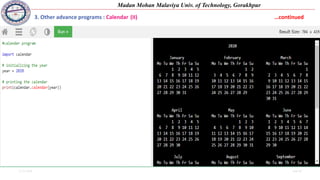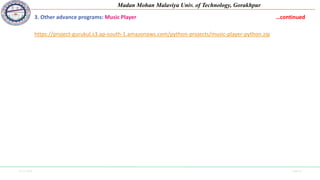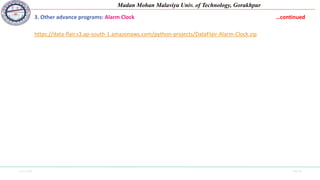Ad
Python Programming Unit 4 Problem Solving and Data Analysis
- 1. PROGRAMMING IN PYTHON MCA-161 4 Credits (3-0-2) MCA 5th Sem (2020-21) R K Dwivedi Assistant Professor Department of ITCA MMMUT Gorakhpur
- 2. UNIT IV: Advance Concepts A. Problem solving: • Use of Python to solve real time problems • How Python helps to research problems • Creating various types of graphs corresponding to any data to show different kinds of results and analysis B. Data Analysis: • Understanding problems of data science and machine learning • Creating codes for data analysis problems in Python • Other advance programs
- 3. 11-11-2020 Side 3 Madan Mohan Malaviya Univ. of Technology, Gorakhpur A. Problem solving
- 4. 11-11-2020 Side 4 Madan Mohan Malaviya Univ. of Technology, Gorakhpur 1. Use of Python to solve real time problems
- 5. 11-11-2020 Side 5 Madan Mohan Malaviya Univ. of Technology, Gorakhpur 1. Use of Python to solve real time problems • Python can be used on a server to create web applications. • It can be used to create GUI based desktop applications(Games, Scientific and Business Applications). • It is also used to create test frameworks and multimedia applications. • It is used to develop operating systems and programming language. • It can be used to handle image processing, text processing and natural language processing. • It can be used to create programs for machine learning, deep learning, data science, big data and data analytics applications. • It can also perform complex mathematics along with all cutting edge technology in software industry. Organizations and tech-giant companies using Python : 1) Google(Components of Google spider and Search Engine) 2) Yahoo(Maps) 3) YouTube 4) Mozilla 5) Dropbox 6) Microsoft 7) Cisco 8) Spotify 9) Quora 10) Instagram 11)Amazon 12)Facebook 13)Uber etc.
- 6. 11-11-2020 Side 6 Madan Mohan Malaviya Univ. of Technology, Gorakhpur 1. Use of Python to solve real time problems …continued Some Real Time Projects, their Python Codes and Datasets : https://data-flair.training/blogs/python-project-ideas/ https://data-flair.training/blogs/django-project-ideas/ https://data-flair.training/blogs/data-science-project-ideas/ https://data-flair.training/blogs/artificial-intelligence-project-ideas/ https://data-flair.training/blogs/machine-learning-project-ideas/ https://data-flair.training/blogs/deep-learning-project-ideas/ https://data-flair.training/blogs/iot-project-ideas/ https://data-flair.training/blogs/computer-vision-project-ideas/ https://archive.ics.uci.edu/ml/datasets.php https://www.kaggle.com/datasets https://github.com/topics/covid-19
- 7. 11-11-2020 Side 7 Madan Mohan Malaviya Univ. of Technology, Gorakhpur 2. How Python helps to research problems
- 8. 11-11-2020 Side 8 Madan Mohan Malaviya Univ. of Technology, Gorakhpur 2. How Python helps to research problems It can be used in various types of research areas such as: • Image Processing • Text Processing • Natural Language Processing • Machine Learning • Deep Learning • Data Science • Big Data Analytics
- 9. 11-11-2020 Side 9 Madan Mohan Malaviya Univ. of Technology, Gorakhpur 3. Creating various types of graphs corresponding to any data (to show different kinds of results and analysis)
- 10. 11-11-2020 Side 10 Madan Mohan Malaviya Univ. of Technology, Gorakhpur 1. Creating various types of graphs corresponding to any data (to show different kinds of results and analysis) • Matplotlib is a graph plotting library in python that serves as a visualization utility. • NumPy (Numerical Python) is a python library used for working with arrays. • NumPy also has functions for working in the domain of linear algebra, fourier transform, and matrices. • subplot( ) allows to draw multiple plots in one fig. (subplot(no of rows, no of columns, index of current plot) • All modern browsers support 140 color names (Syntax: color=‘r’ or color=‘red’ or c=‘r’ or c=‘red’). • A hexadecimal color is specified with: #RRGGBB (Syntax: color=‘#0000ff’ or c=‘0000ff’). A. Line Graph: • linestyle can be written as ls in a shorter syntax. • linewidth can be written as lw in a shorter syntax. • color can be written as c in a shorter syntax. linestyle short syntax solid' (default) '-' 'dotted' ':' 'dashed' '--' 'dashdot' '-.' 'None' '' or ' ' 'r' - Red 'g' - Green 'b' - Blue 'c' - Cyan 'm' - Magenta 'y' - Yellow 'k' - Black 'w' - White
- 11. 11-11-2020 Side 11 Madan Mohan Malaviya Univ. of Technology, Gorakhpur 1. Creating various types of graphs corresponding to any data (to show different kinds of results and analysis) …continued
- 12. 11-11-2020 Side 12 Madan Mohan Malaviya Univ. of Technology, Gorakhpur 1. Creating various types of graphs corresponding to any data (to show different kinds of results and analysis) …continued B. Bar Graph: • The default width value of the bars is 0.8. • bar ( ) function displays the bar graph vertically and barh( ) function displays the bar graph horizontally.
- 13. 11-11-2020 Side 13 Madan Mohan Malaviya Univ. of Technology, Gorakhpur 1. Creating various types of graphs corresponding to any data (to show different kinds of results and analysis) …continued
- 14. 11-11-2020 Side 14 Madan Mohan Malaviya Univ. of Technology, Gorakhpur 1. Creating various types of graphs corresponding to any data (to show different kinds of results and analysis) …continued C. Pie Chart: • By default the plotting of the first wedge starts from the x-axis and move counterclockwise. • pie( ) function is used to draw the pie charts. • pie(populationShare, labelsWedge, colors, startAngle, explode, shadow) • legend(title = "Four Fruits:", loc='lower right') Location String Location Code 'best' 0 'upper right' 1 'upper left' 2 'lower left' 3 'lower right' 4 'right' 5 'center left' 6 'center right' 7 'lower center' 8 'upper center' 9 'center' 10
- 15. 11-11-2020 Side 15 Madan Mohan Malaviya Univ. of Technology, Gorakhpur 1. Creating various types of graphs corresponding to any data (to show different kinds of results and analysis) …continued
- 16. 11-11-2020 Side 16 Madan Mohan Malaviya Univ. of Technology, Gorakhpur 1. Creating various types of graphs corresponding to any data (to show different kinds of results and analysis) …continued
- 17. 11-11-2020 Side 17 Madan Mohan Malaviya Univ. of Technology, Gorakhpur 1. Creating various types of graphs corresponding to any data (to show different kinds of results and analysis) …continued D. Histogram: • A histogram is a graph showing frequency distributions. • It is a graph showing the number of observations within each given interval. • hist() function to create histograms. • Create a histogram to represent following: ❖ 2 people from 140 to 145cm ❖ 5 people from 145 to 150cm ❖ 15 people from 151 to 156cm ❖ 31 people from 157 to 162cm ❖ 46 people from 163 to 168cm ❖ 53 people from 168 to 173cm ❖ 45 people from 173 to 178cm ❖ 28 people from 179 to 184cm ❖ 21 people from 185 to 190cm ❖ 4 people from 190 to 195cm • For this, function numpy.random.normal(170, 10, 250) can be used which shows that NumPy uses Normal Distribution to randomly generate an array with 250 values, where the values will concentrate around 170, and the standard deviation is 10.
- 18. 11-11-2020 Side 18 Madan Mohan Malaviya Univ. of Technology, Gorakhpur 1. Creating various types of graphs corresponding to any data (to show different kinds of results and analysis) …continued
- 19. 11-11-2020 Side 19 Madan Mohan Malaviya Univ. of Technology, Gorakhpur B. Data Analysis
- 20. 11-11-2020 Side 20 Madan Mohan Malaviya Univ. of Technology, Gorakhpur 1. Understanding problems of data science and machine learning
- 21. 11-11-2020 Side 21 Madan Mohan Malaviya Univ. of Technology, Gorakhpur 1. Understanding problems of data science and machine learning A. Introduction:
- 22. 11-11-2020 Side 22 Madan Mohan Malaviya Univ. of Technology, Gorakhpur 1. Understanding problems of data science and machine learning …continued B. Procedure:
- 23. 11-11-2020 Side 23 Madan Mohan Malaviya Univ. of Technology, Gorakhpur 1. Understanding problems of data science and machine learning …continued C. Applications:
- 24. 11-11-2020 Side 24 Madan Mohan Malaviya Univ. of Technology, Gorakhpur 1. Understanding problems of data science and machine learning …continued A. Introduction:
- 25. 11-11-2020 Side 25 Madan Mohan Malaviya Univ. of Technology, Gorakhpur 1. Understanding problems of data science and machine learning …continued B. Relation among AI, ML, NN, and DL:
- 26. 11-11-2020 Side 26 Madan Mohan Malaviya Univ. of Technology, Gorakhpur 1. Understanding problems of data science and machine learning …continued C. Types of ML: •Supervised Learning – Train Me! •Unsupervised Learning – I am self sufficient in learning •Reinforcement Learning – My life My rules! (Hit & Trial)
- 27. 11-11-2020 Side 27 Madan Mohan Malaviya Univ. of Technology, Gorakhpur 1. Understanding problems of data science and machine learning …continued D. Techniques used in ML:
- 28. 11-11-2020 Side 28 Madan Mohan Malaviya Univ. of Technology, Gorakhpur 1. Understanding problems of data science and machine learning …continued E. Procedure (View 1) Usually 80% data for training, and 20% data for testing
- 29. 11-11-2020 Side 29 Madan Mohan Malaviya Univ. of Technology, Gorakhpur 1. Understanding problems of data science and machine learning …continued E. Procedure (View 2)
- 30. 11-11-2020 Side 30 Madan Mohan Malaviya Univ. of Technology, Gorakhpur 1. Understanding problems of data science and machine learning …continued E. Procedure (View 3)
- 31. 11-11-2020 Side 31 Madan Mohan Malaviya Univ. of Technology, Gorakhpur 1. Understanding problems of data science and machine learning …continued F. Applications (View 1):
- 32. 11-11-2020 Side 32 Madan Mohan Malaviya Univ. of Technology, Gorakhpur 1. Understanding problems of data science and machine learning …continued F. Applications (View 2):
- 33. 11-11-2020 Side 33 Madan Mohan Malaviya Univ. of Technology, Gorakhpur 1. Understanding problems of data science and machine learning …continued F. Applications (View 3):
- 34. 11-11-2020 Side 34 Madan Mohan Malaviya Univ. of Technology, Gorakhpur 2. Creating codes for data analysis problems in Python
- 35. 11-11-2020 Side 35 Madan Mohan Malaviya Univ. of Technology, Gorakhpur 2. Creating codes for data analysis problems in Python First of all, import or load the dataset and then analyse it. A. The basic process of loading data from a CSV file with Pandas # Load the Pandas libraries with alias 'pd' import pandas as pd # Read data from file 'filename.csv' (in the same directory) data = pd.read_csv("filename.csv") # Preview the first 5 lines of the loaded data data.head() import pandas filename = ‘indians-diabetes.data.csv' names = ['preg', 'plas', 'pres', 'skin', 'test', 'mass', 'pedi', 'age', 'class'] data = pandas.read_csv(filename, names=names) print(data.shape) OR
- 36. 11-11-2020 Side 36 Madan Mohan Malaviya Univ. of Technology, Gorakhpur 2. Creating codes for data analysis problems in Python …continued C. The basic process of loading data from a CSV file with Python Standard Library B. The basic process of loading data from a CSV file with NumPy import numpy filename = 'indians-diabetes.data.csv' raw_data = open(filename, 'rt') data = numpy.loadtxt(raw_data, delimiter=",") print(data.shape) import csv import numpy filename = 'indians-diabetes.data.csv' raw_data = open(filename, 'rt') reader = csv.reader(raw_data, delimiter=‘,’ , quoting=csv.QUOTE_NONE) x = list(reader) data = numpy.array(x).astype('float') print(data.shape)
- 37. 11-11-2020 Side 37 Madan Mohan Malaviya Univ. of Technology, Gorakhpur 2. Creating codes for data analysis problems in Python …continued D. Data Analysis
- 38. 11-11-2020 Side 38 Madan Mohan Malaviya Univ. of Technology, Gorakhpur 3. Other advance programs
- 39. 11-11-2020 Side 39 Madan Mohan Malaviya Univ. of Technology, Gorakhpur 3. Other advance programs: Calendar (I)
- 40. 11-11-2020 Side 40 Madan Mohan Malaviya Univ. of Technology, Gorakhpur 3. Other advance programs : Calendar (II) …continued
- 41. 11-11-2020 Side 41 Madan Mohan Malaviya Univ. of Technology, Gorakhpur 3. Other advance programs: Calculator …continued https://data-flair.s3.ap-south-1.amazonaws.com/python-projects/dataflair-python-calculator.zip
- 42. 11-11-2020 Side 42 Madan Mohan Malaviya Univ. of Technology, Gorakhpur 3. Other advance programs: Currency Converter …continued https://data-flair.s3.ap-south-1.amazonaws.com/python-projects/currency-converter-project.zip
- 43. 11-11-2020 Side 43 Madan Mohan Malaviya Univ. of Technology, Gorakhpur 3. Other advance programs: Music Player …continued https://project-gurukul.s3.ap-south-1.amazonaws.com/python-projects/music-player-python.zip
- 44. 11-11-2020 Side 44 Madan Mohan Malaviya Univ. of Technology, Gorakhpur 3. Other advance programs: Alarm Clock …continued https://data-flair.s3.ap-south-1.amazonaws.com/python-projects/DataFlair-Alarm-Clock.zip
- 45. Queries ?
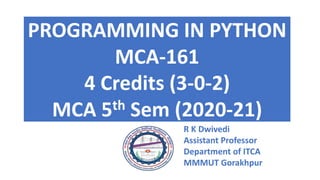







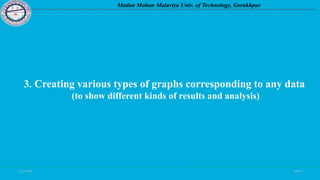
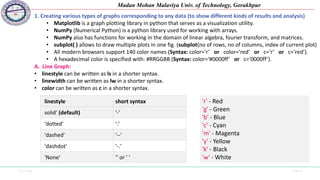






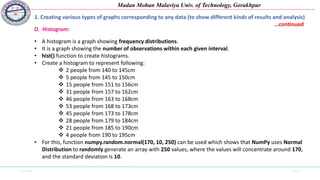
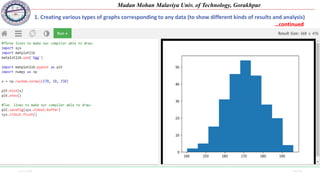














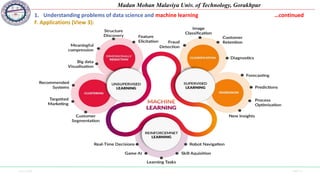

![11-11-2020 Side 35
Madan Mohan Malaviya Univ. of Technology, Gorakhpur
2. Creating codes for data analysis problems in Python
First of all, import or load the dataset and then analyse it.
A. The basic process of loading data from a CSV file with Pandas
# Load the Pandas libraries with alias 'pd'
import pandas as pd
# Read data from file 'filename.csv' (in the same directory)
data = pd.read_csv("filename.csv")
# Preview the first 5 lines of the loaded data
data.head()
import pandas
filename = ‘indians-diabetes.data.csv'
names = ['preg', 'plas', 'pres', 'skin', 'test', 'mass', 'pedi', 'age', 'class']
data = pandas.read_csv(filename, names=names)
print(data.shape)
OR](https://image.slidesharecdn.com/mca-306unit4-241011072731-6b826771/85/Python-Programming-Unit-4-Problem-Solving-and-Data-Analysis-35-320.jpg)




